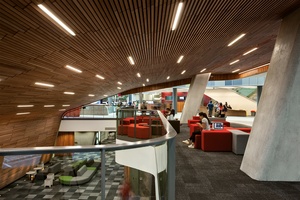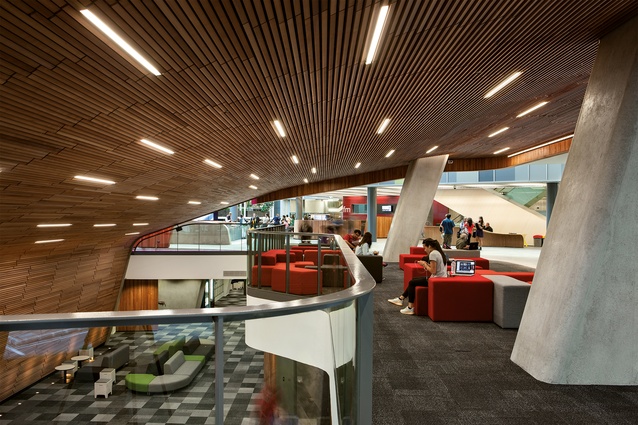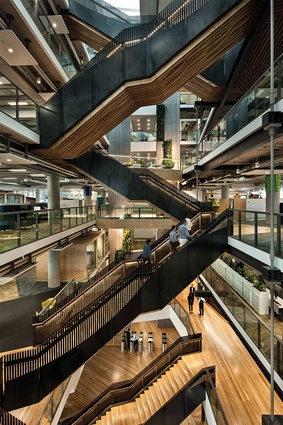Designer interview: Kathryn Roberts
Senior interior designer Kathryn Roberts recently joined Jasmax as associate principal and interior design lead. She sat down with Federico Monsalve to discuss her views on the industry.
Federico Monsalve (FM): What do you think are some of the biggest lessons interior designers need to learn from the pandemic?
Kathryn Roberts (KR): Since we were forced to adapt and flex really quickly, I believe the workplace will be more malleable and open to change, and there will be an even stronger push for ways to enhance collaboration and ease of communication through technology.
Businesses will be able to act quickly and more easily to challenges, and the balance of work, health and wellbeing will be stronger. People have realised that lots of good work happens when you are not necessarily sitting in the office. Often, working in other environments can actually stimulate more focussed work and more creative thinking.

The flip side of that is coming back to the office, you do realise that there are really key benefits to having that physical office space and the office culture and bump spaces and the connectivity that you get with having face-to-face interactions.
FM: If the office is not dying… can you predict how it will change?
KR: We are in an experiment that we did not know was coming. Businesses have been launched into that ‘future ways of working’ that we have been talking about for some time now. With agile ways of working, businesses have been looking to reduce physical real estate by providing less individual desks in favour of more flexible typologies and settings, although getting the balance of reducing real estate and allowing room for future growth is complex and layered. It would seem intuitive in some cases to reduce floor space and utilise shared working systems, but it is highly individualised to each company.
FM: You have had some overseas experiences as design lead for large tech campuses in Seoul and Silicon Valley (HP and Google, respectively). Is there anything from those projects you feel can be adopted locally?
KR: Because the tech scene is so competitive and there are so many options at play for in-demand industry professionals and graduates, tech giants are constantly trying to attract and retain talent and offer their staff the best. Things like adopting more flexible hours, encouraging public transport and zero-carbon ways of commuting, providing nutritious snacks for staff, supporting and promoting other local businesses. Locally, I think we can take some of these approaches and find ways for companies to support local businesses – subsidised rates at gyms, discounts at coffee and sandwich bars, drycleaning, etc. But also designated areas for wellness, such as end of trip facilities and mindfulness/meditation suites, could be explored more.

FM: Are there any other sectors or typologies where you see these strategies and lessons being useful? Can these be translated, for instance, into higher density residential or education?
KR: Blurring the boundaries between sectors is something we continue to explore and develop in the ever-changing world of work and design, and we are prioritising spaces that are social and more casual. The education sector, particularly tertiary education, takes cues from workplace environments and is becoming more grown up, with spaces designed to help equip students with the social and organisational behaviours that come with the workplace. We are creating environments for activity-based learning, much like the activity-based working in the workplace realm. Workplaces are influenced by hospitality sectors to have a sense of comfort/home/luxury, and high-end residential like public and civic design.
Design is holistic and fluid. It is about humanising architecture and creating spaces designed with performance and place forefront. With high density living, the focus and benefit is often around the community that is built and the neighbourhood amenity.
FM: Is there an area of commercial interiors that is ripe for re-invention, disruption or, at least, a rethink?
KR: Interior design practice is becoming more streamlined. We are working to tighter timeframes and turning around better design, quicker. This is largely enabled through technology. Innovative platforms such as virtual reality, 3D printing, as well as visualisation and 3D modelling tools allow us to elevate the design process and convey our ideas rapidly. This increases expectations from clients for high-quality realist renders of their projects. It also means, with the world becoming smaller and smaller, that we are able to stay competitive, as technology allows us to connect with anyone in any location globally. Virtual reality allows us to walk our clients through the model and experience a space at concept stage. We are able to swap out finishes before their eyes, look left, right, up, down, move walls, add doors, walk past other people in the model, all in real-time and total immersion. When clients have the ability to use designers from other parts of the world, it is important we hold our ground and can show our value of boots on the ground locally, through building strong, enduring relationships.

FM: Is that in any way changing how architecture and interior design relate to each other?
KR: My view is that interiors should always be informing the architecture. We’re always trying to humanise architecture, right? And that comes from a tactile sort of stance, from designing at a human scale versus just the big, grand statement. I think, yes, technology is helping put interior design at a level playing field with architecture.
FM: What excites you about working for Jasmax at this point in time?
KR: I’m excited about the recent manifesto that talks about us being of the land and our strong drive towards sustainability and elevating bicultural design outcomes. I think this is a real differentiator from other firms. That’s a really exciting area to be in at the moment, recognising that we’re not all the same and that our diversity is our strength – we have different beliefs and desires and points of view and recognising that, I think, creates a much richer design at the end of the day.














